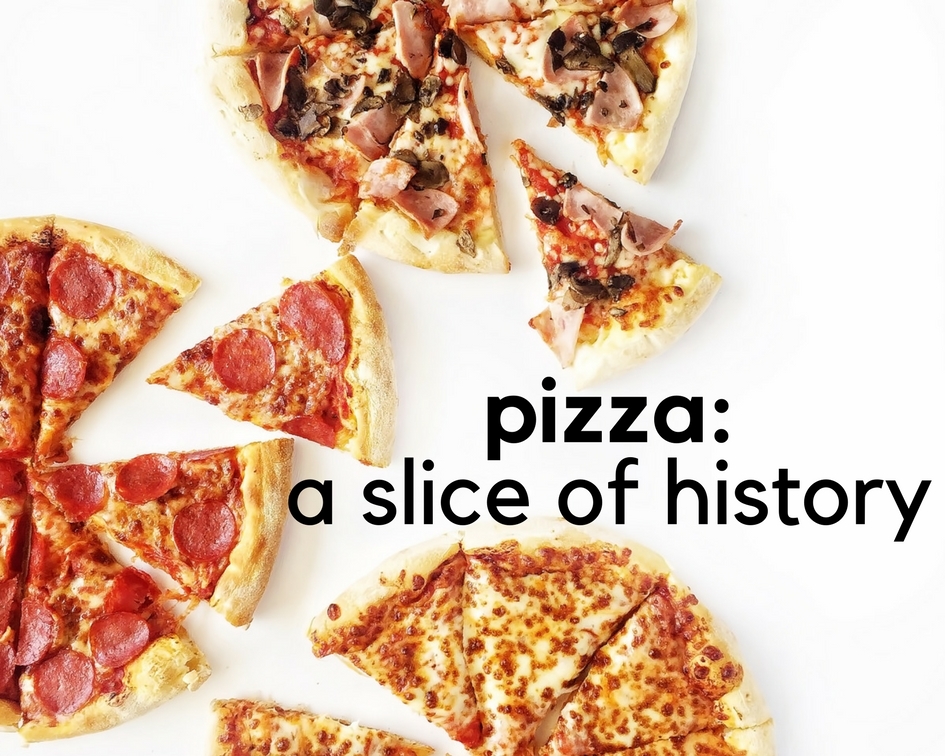According to the U.S. Department of Agriculture, one in eight American adults eats pizza on any given day. It’s a grab and go lunch or an easy take-out dinner at home. Across the United States in many households, Friday night is pizza night. Did you order pizza for the Super Bowl? You weren’t the only one. Super Bowl Sunday is one of the biggest days to eat pizza. But where did pizza originate? Here’s a quick look at the history of pizza.
The first documentation of the word pizza was in 997 in Gaeta a city in central Italy about 50 miles from Naples. It’s the Italian word for pie and thought to be from an Old Italian word meaning “a point.” It’s origins, though, date back many, many years earlier.
Variations of pizza were made back in the Stone Age where people cooked a bread under stones of a fire and added ingredients on top to make it more flavorful. Ancient Greeks made plankuntos, a flatbread with toppings like herbs, onion, and garlic (similar to what we’d now call focaccia). The soldiers of Persian King Darius in the 6th century BC, would bake flatbread on their battle shields and top with cheese. Some suggest modern pizza dates back 2000 years when Roman soldiers added topping to their matzah.
But, what we now know as pizza dates back to the 16th century in Naples, Italy. A flatbread was sold on the streets that the working class could eat quickly. It was also a way for bakers to use extra dough.
In 1522, tomatoes were brought back from Peru and the poorer class of Naples began eating them. They were placed on top of the dough creating the first iteration of today’s pizza. By the 17th century, locals would flock to the poorer areas of Naples to dine on”pizzaiolo.”
Purists will say there are only two types of pizza – marinara and Margherita. Marinara pizza consists of tomato, oregano, garlic and olive oil. It was named marinara because it was often prepared by “la marinara” or seaman’s wife for her husband returning from fishing trips in Naples.
Margherita pizza was developed in 1889, to honor Queen Margherita, the queen of Italy. Pizzamaker Raffaele Esposito created topped the dough with tomatoes, mozzarella, and basil to mimic the colors of the Italian flag. He named it Pizza Margherita and the Queen became a huge fan of the pizza.
Italian immigrants brought their love of pizza to the United States in the late 19th century. Peddlers would sell slices in cities like New York, Chicago, Philadelphia, and Saint Louis. Giovanni and Gennaro Bruno introduced Neapolitan pizza to Chicago in 1904 and opened up the first pizzeria.
Gennaro Lombardi opened a store in New York City on Spring Street in 1897 that sold pizza among other things. Thanks to receiving one of the first mercantile licenses in 1905, the store is now known as the first official pizzeria. In fact, Lombardi’s has since moved down the street but is still selling thin-crust Neapolitan pizza. It was not until World War II, however, that pizza became very popular in the United States.
US troops in Italy were always on the lookout for new foods to accompany their rations. They found pizza and locals had a hard time keeping up with their demand. As the troops came back from World War II, the demand for pizza got stronger and stronger in the United States.
Slowly, regions were putting their own twists on pizza. In 1943, Ike Sewell and Ric Riccardo invented the Chicago-style deep dish pizza and opened Pizzeria Uno. By the 1950’s chains were popping up all over the country.
Today, there are so many variations of pizza. Thin or thick crust; Sicilian, Chicago or Neapolitan style; meat lover or veggie … there’s a pie for everyone. It’s been called the world’s most popular food for a reason. So what’s your favorite pizza? Tell us below!
Are you inspired to make homemade pizza? Check out these Blue Ribbon pizza recipes.
Chicken Bacon Ranch Pizza
“Not only is it yummy, it makes 2 hearty pizzas for a fraction of the cost of ordering out.” – The Kitchen Crew
Sweet Home Chicago Style Deep Dish Pizza
“Why travel to Chicago for authentic deep dish pizza when you can make it at home?! The pizza crust has so much flavor from the garlic and basil and the homemade sauce really shines through.” – The Kitchen Crew
Susie’s Bacon Cheeseburger Pizza
“This pizza has the perfect homemade crust as a base. It is thick and slightly chewy… just the right texture. Honestly, this does taste like a bacon cheeseburger in pizza form.” – The Kitchen Crew
Spicy Mediterranean Pizza
“The arrabbiata sauce really does bring a depth of flavor to this pizza. It’s spicy, tangy, and delicious.” – The Kitchen Crew
